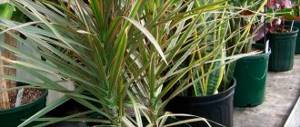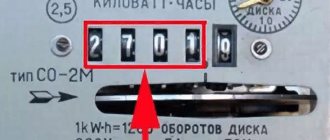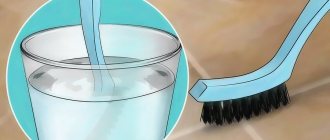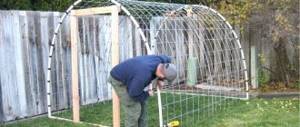Do-it-yourself greenhouse, what you need to know Everyone who personally grows vegetables on their own plot sooner or later thinks about using a greenhouse or greenhouse.
Yes, having a greenhouse at your dacha is beneficial. In it, you can not only quickly grow seedlings for subsequent transplantation into open ground, but also get a harvest of some vegetables and herbs throughout the year, regardless of weather conditions.
If you have a spacious and well-lit area, you can safely build a greenhouse. It can be used all year round without spending money on buying vegetables and herbs in the store. In small summer cottages, greenhouses can be used.
Many summer residents often have a dilemma: buy ready-made structures from a manufacturing plant or build them yourself?
It all depends on your capabilities. Of course, do-it-yourself greenhouses are the most attractive in terms of price.
But if you do not have time to manufacture the main parts, assemble and install the structure, or you are unable to do this work due to health reasons or age, then in this case there is only one option - to order from the factory.
Our website presents the best greenhouse projects for a summer residence, which you can make yourself without any problems.
Some projects require a welding machine and experience in welding, others can be made from scrap materials using a minimum of tools.
Why is it better to build a greenhouse yourself: pros and cons
Of course, the first, and perhaps the biggest, plus is cost savings. Homemade designs will cost less than factory ones.
We have tried to collect for you budget options for do-it-yourself greenhouses and the best projects for capital structures that will serve you for many years.
You can make homemade structures taking into account the terrain and your own preferences. Yes, and you can use different materials, even those that are at hand.
Even if you have never built greenhouses or greenhouses before, then on our website you will find step-by-step instructions on what and how to do.
If necessary, the structure can be made collapsible or monolithic. This is also very important.
Another important point is the dimensions of the structure. You can decide for yourself what the greenhouse or greenhouse will be like: compact or spacious, like a greenhouse.
In general, as you can see, there are a lot of positive aspects, ranging from cost savings, choice of installation location, shape and size of the constructed structure, and ending with the choice of materials.
What could be the disadvantages? In fact there are not many of them. The first point is drawing up a drawing. Here you need to take into account certain nuances, and not every ordinary summer resident may know about them. But you can find a ready-made drawing with dimensions on the Internet.
The next point is having the necessary tool and experience working with it. In particular, we are talking about welding. When making a solid metal frame, there is no way to do without it.
If you have no experience in welding, you can turn to friends and acquaintances for help. Or even neighbors. In general, this problem is completely solvable if desired.
When making an arched greenhouse, as well as “Butterfly” or “Breadbox” type greenhouses from a profile pipe, you will need to bend the profile into half-arches. For this you will need a profile bender.
It is clear that not every summer resident has this machine available. But again, there are no hopeless situations.
You can make arcs of the required size in metalworking shops. Or you can simply make a profile bending machine yourself - you can read about this in detail in this article.
Common types and forms of greenhouses
When choosing the shape of a greenhouse, you need to start not only from personal preferences, but also be guided by some other considerations.
For example, if you are going to build a greenhouse in areas where there is a lot of rainfall in winter, the structure should have a well-thought-out shape so that the snow does not lie on the roof and overload the frame.
If we talk about the most common forms of construction, the most popular among summer residents are greenhouses and greenhouses of the arched type and with straight walls (one- or two-slope).
Various country greenhouses in the shape of polygons and pyramids are rarely used, mainly due to the complexity of assembly. But some people prefer such designs.
Let's look at all the most popular types and forms of greenhouses, so that it is clear what to focus on when choosing.
Winter and summer
If greenhouses are predominantly seasonal buildings that are used from spring to autumn, then greenhouses can be used all year round. But at the same time they are conventionally divided into summer and winter.
Typically, collapsible greenhouses are used as summer structures so that they can be removed from the site for the winter. The coating is most often film (it is designed for 1-2 seasons).
A winter home greenhouse differs from a summer one in a number of ways: it must have heating and internal lighting, and may additionally have forced ventilation and an automatic watering system.
Both winter and summer non-demountable structures must be manufactured in accordance with certain requirements:
- the frame must be strong enough to effectively withstand snow and wind loads;
- there must be a foundation (preferably concrete);
- The greenhouse coating must be of high quality, with good light transmittance and, most importantly, frost-resistant.
Not all summer residents can afford winter greenhouses, but if there is such an opportunity, it is better to invest money in them - all construction and operating costs will pay off very quickly.
Stationary and collapsible
When choosing a design type, first of all, you need to take into account the operating conditions.
If you need a permanent greenhouse, which you plan to install in one specific place and use it for a long time, then choose a stationary greenhouse on a foundation. You can find out how to make a stationary greenhouse on our website.
Such structures are strong and reliable, but at the same time the costs of their construction will be higher.
Collapsible greenhouses - as a rule, have less weight and less strength, but are highly mobile. They can be easily disassembled for the winter.
Collapsible frames will be preferable in cases where you want to try how the greenhouse will “work” in a specific area, and if something happens (if the result does not suit you) - move the structure to another place.
Arched
They are easy to assemble. Installation takes little time; you can even cope with the installation of such a structure alone.
Greenhouses can be used not only in the warm season, but also all year round. In winter, thanks to the presence of an arched vault, snow does not accumulate on the roof. Only it is better to use polycarbonate rather than film coating.
In the process of constructing arched-type greenhouses, there is no need to build a capital foundation made of concrete or wooden beams (the only exception is large structures).
Single-pitch
Such greenhouses can be installed either independently or as an extension to a house or other building on the site.
They are quite spacious and bright. But in winter, when there is precipitation, it will be necessary to regularly clear the snow from the roof.
Little house
This design has straight walls and a gable roof. One of the most popular greenhouses for summer cottages because it is spacious and bright.
Universal - suitable for growing almost any plant. It’s worth making a greenhouse with your own hands if you plan to grow tall vegetable crops.
A drop
The teardrop-shaped design of a homemade country greenhouse is perfectly suited for use in winter. Thanks to the special shape of the roof, snow practically does not linger on it.
Since the greenhouse frame consists of half-arches, additional reinforcement with transverse guides is required. The more there are, the more rigid the structure will be.
Dome
The frame has a hemispherical shape, which visually distinguishes this design from classical types of greenhouses.
Among the main advantages of dome structures, it is worth noting good stability due to uniform load distribution and resistance to strong gusts of wind due to the streamlining of the dome.
Description and characteristics
A greenhouse is a small structure whose task is to protect garden crops and other plants from adverse weather conditions. This design is not heated. The greenhouse consists of a side fence and a removable roof that allows sunlight to pass through unhindered. The covering material creates an isolated space inside the structure with a certain microclimate.
Did you know? There was a Crystal Palace made of glass and metal in London's Hyde Park. The structure was erected in 1851 under the patronage of Prince Albert to host the World Exhibition. It was destroyed by fire in 1936.
For the first time, structures similar to modern greenhouses began to be used in the era of Ancient Rome. They were stationary or mobile (carried on carts) and covered with caps. They were used to grow plants imported from hot countries. In the 13th century, the Italians figured out how to equip a greenhouse heating system, and thus turned it into a greenhouse. Tropical ornamental plants began to be grown in heated buildings - this is how greenhouses appeared.
When these structures became widespread among the Italian nobility, other European countries also became interested in them. In the 18th century, the technology of growing plants indoors came to Russia. Due to the harsh climate, greenhouses were initially used here, but soon popularity shifted to greenhouses due to the simplicity of their design.
Main characteristics of the greenhouse:
- the building is low - no more than 130 cm;
- heating is carried out due to the sun and heat generated by organic matter (manure, humus);
- suitable for growing seedlings, especially early varieties;
- has a mobile design that is easy to move around the site;
- the structure does not have doors, so to gain access to the bed, you need to either lift the entire structure or remove part of the covering material;
- for construction you do not need to have special skills and abilities;
- A greenhouse is a seasonal thing, usually only for spring.
Find out also how to make a greenhouse for seedlings.
Wall mounted
Such greenhouses are good because they can be used in winter without major financial investments, since it is not at all difficult to organize the flow of heat into the greenhouse directly from home.
Please pay attention to one important point - wall structures must be installed on the south side (this is important!).
Greenhouse fence
Can act as a stand-alone fence or in combination with an existing fence.
This option attracts many summer residents because it allows not only to save space on the site. You can also save on materials, which, of course, is good news.
Thermos
One of the most successful options for use in winter. This design allows you to grow vegetables even in severe frosts.
Underground
Such structures are buried 1.5-2 meters into the ground. The coating most often used is polycarbonate.
When using such a greenhouse in winter, there is usually no need to install heating equipment. But the costs of its construction are still considerable.
How long can polycarbonate last?
Polycarbonate sheet can last up to 20 years. This is the period stated by most trusted manufacturers. But such service life of cellular polycarbonate can only be guaranteed by European companies that produce sheets with a thickness of 12 mm to 22 mm.
Comparison with Russian materials is not reassuring - a polycarbonate sheet of the same width will last only ten years . The Chinese analogue, made from recycled materials, can only last 5-7 years. And these deadlines are not always met by the material.
Everything you need to have in a country house
What materials to choose for the frame? Which one is better?
These can be a variety of materials, depending on the design of the greenhouse, its size and operating conditions, as well as financial capabilities and available tools.
Metal profile
Profile pipe is the most popular material. There is a lot of information on the Internet (including on our website) about how to build a greenhouse from a profile.
Metal profile is a strong, durable and reliable material. And the frame made from it is resistant to loads.
On YouTube you can even find videos of greenhouses made from plasterboard profiles - an excellent option for building small lightweight structures without a foundation.
Steel
In this case we are talking about the use of metal round pipes, as well as fittings and round or square steel rods. The frame is rigid and durable, but requires maintenance (protection from corrosion).
Aluminum
Using an aluminum profile and round pipes, you can create a lightweight frame - suitable for small structures.
Tree
One of the most affordable and accessible materials. No welding is required in the manufacture of wooden frames. But if we are building a greenhouse from wood, then we must use protective impregnations with antiseptic properties or paint.
Plastic
One of the most versatile materials. Not afraid of corrosion, UV resistant, lightweight and durable. As a rule, polypropylene, PVC or HDPE pipes are used.
Available materials
In addition to the above materials, you can also use what you have on hand. For example, old window frames, plastic bottles and much more.
Greenhouse construction
Laying a foundation is required only for a stationary greenhouse structure for products made of polycarbonate or glass.
To do this, before starting work, the fertile layer of soil is removed, the rest is thoroughly compacted.
The ideal option for the foundation of a greenhouse is the so-called tape-reinforced type, the depth of which is 25 centimeters or more.
4-5 days after pouring the foundation, you can begin installing the frame. This is an integral part of every greenhouse, for this reason its integrity and quality must be given maximum attention. Usually the frame is made of wood, plastic or metal profile.
How to choose a quality shade net for plants in a greenhouse
Which covering material is better?
Various materials can be used to cover a greenhouse. Let's look at their key features.
Spunbond
It is a non-woven polymer material. It is an alternative to film coating and polycarbonate. Very durable and resistant to negative environmental factors.
Polycarbonate
The most popular material. Very often you can find arched greenhouses made of polycarbonate. Safer than glass, quite durable and holds heat well. Inexpensive.
PVC film
An ideal covering material for budget and small greenhouses. Despite the fact that it has to be changed often (every 1-2 seasons), this does not break the bank. And the most important thing is that every summer resident can build a greenhouse with his own hands from film.
Glass
Typically used in greenhouses made from window frames. Excellent material in terms of thermal insulation properties and light transmittance. But quite fragile. Not recommended for use on the roof.
Agrofibre
A fairly durable material that is not afraid of bad weather. Withstands both strong gusts of wind and rain and hail. Excellent retention of moisture inside the greenhouse itself.
Reinforced fabric
This material has worse light transmission compared to film coating, but is more durable and durable. You don't have to change it every year.
Unusual buildings
- A mini-greenhouse is a cap made from a plastic bottle without a bottom, it is easy to make and is great for growing seedlings of plants that are painful to transplant. Immediately after planting the seeds, the cap must be closed with a lid, and when the temperature during the day is above 20 degrees, it can be removed.
- Neat houses made from old window frames help ensure comfortable growth for plants and serve as a stunning decoration for a summer cottage.
- The dome is a large polygonal building with a wooden frame covered with ordinary oilcloth. Despite the complexity of construction, this dome-shaped structure is attractive, stable and has excellent light penetration.
- The box, consisting of four boards and a window frame, is a small original greenhouse for flowers and low-growing plants.
- A practical folding greenhouse made from modern small-diameter PVC pipes and regular polyethylene film.
- A greenhouse umbrella is a small original design made from a wooden barrel and an old oilcloth umbrella covered with plastic film.
- A greenhouse tent is a compact mobile structure made from a children's tent with walls equipped with oilcloth inserts.
- A plastic house is a greenhouse made from plastic bottles, which can be open or closed. Creating such a greenhouse does not require large expenses or special skills.
- A flowerbed is a small greenhouse made from a wooden frame of the required size, two thin plastic pipes and a piece of oilcloth. The convenience of this design is that if the air temperature rises to the required level, the oilcloth can be easily removed, and you will get a neat flowerbed.
- A mini-house is a cute greenhouse made of plastic boxes that is suitable for indoor plants and will decorate any standard balcony.
- It is enough to simply build a small greenhouse from old pallets covered with plastic film. This design is perfect for growing flowers and seedlings.
- From a standard plastic container you can build an excellent greenhouse for growing seedlings on the balcony.
- A reliable box is a kind of miniature greenhouse at home, made from a tall container, which will protect a small indoor flower left on the balcony from cold and moisture.
- Roof - this design involves the construction of a house from wooden boxes and window frames. Best suited for growing flowers and short plants.
- A permanent greenhouse made of polycarbonate is a stable, large and reliable structure with a wooden frame. This type of greenhouse is excellent for growing any plants, which makes its construction difficult and requires some investment of money.
How to make a greenhouse from arcs with covering material
You should not exclude the possibility of purchasing a ready-made greenhouse or greenhouse from trusted companies. You can then benefit from the mandatory guarantee that the product is of high quality for long-term use. In addition, if you receive a defective product, you can exchange the greenhouse during the entire warranty period. Large suppliers offer greenhouses at affordable prices and provide all the information about the materials used for their manufacture.
Types of foundation
The choice of base for a greenhouse depends mainly on the weight of the structure. Heavier frames require a good foundation. But small mini greenhouses can be installed on the simplest base or directly on the ground.
From timber
Making a wooden foundation from square timber is easy and simple. The main thing is not to forget to treat it with protective impregnation and use waterproofing to extend its service life.
Made of brick
This type of foundation can also be considered one of the simplest. And this is also a budget method. Suitable for medium-sized country greenhouses.
From stone
Almost the same as brick. True, the installation of such a base will take less time due to the large size of the stone.
Tape with base
Concrete foundation is one of the most durable and reliable. And the most labor-intensive. Used as a base for the installation of medium and large-sized greenhouses.
You will find DIY greenhouse projects with a concrete strip foundation on our website.
Columnar pile
The main advantage of this type of foundation is that there is no need to level the site. Quite durable and reliable. But not the cheapest option.
Blocky
As strong and reliable as a concrete foundation. Although quite expensive, it is solid and can withstand the weight of large greenhouses.
Monolithic from slabs
Such a foundation is constructed mainly in cases where the soil is mobile, that is, oversaturated with moisture. Quite capital, but expensive.
From scrap materials
Considering budget options for greenhouses, you can make a foundation for them using available materials.
For example, for a small lightweight structure in the form of a homemade greenhouse, an old door frame or window frame can serve as the base.
When can you build a greenhouse without a foundation?
This is possible in cases where the structure is light and small in size. In this case, it is enough to limit ourselves to ordinary lugs that are attached to the frame.
How to improve equipment and arrangement of a greenhouse and what you can save on
The space inside the greenhouse must be used rationally, as it is limited. It is important to provide a passage of sufficient width so that you can comfortably work on two fronts.
There are also some other nuances regarding the arrangement of the greenhouse that you need to pay attention to.
Heating
If you are planning to make a greenhouse with your own hands that can be used in winter, then it is important that it is warm. You can connect it to your home heating system or install a greenhouse stove.
Lighting
Since there is constant humidity inside the greenhouse, you need to use sockets and switches in a protected housing. Any lamps for lighting can be installed.
Ventilation
Ventilating the greenhouse is an important point. There is no need to make a forced ventilation system, but vents must be present.
Watering
You can organize watering in the greenhouse using a garden watering can or hose. But it is better to install a drip irrigation system.











